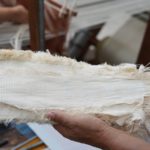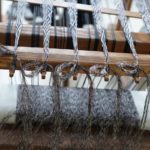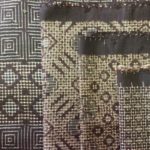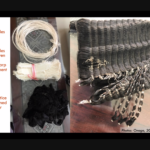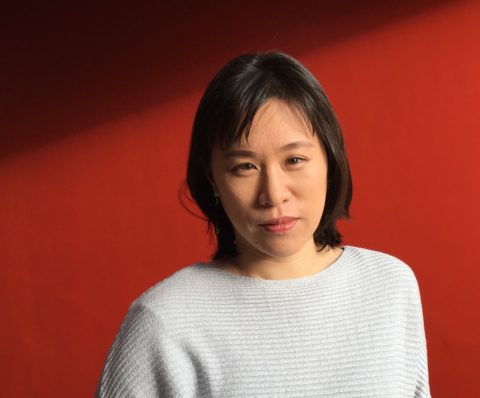
Download
Registration Info
This is a past event. Registration is no longer possible.
Please subscribe to our DIJ Newsletter to stay informed about our research activities, events, and publications:
Silk-Making Knowledge in Amami Ōshima as Critical Archipelagic Heritage
August 18, 2022
Lisa Onaga, Max Planck Institute for the History of Science / DIJ Tokyo
Photos © Lisa Onaga (above left: Kasuri mushiro. Starched raw silk warp and weft are fastened with a cotton warp to create a resist-dye pattern; centre: Dyed warp threads set up on the loom; right: Doro-zome (mud-dyed) Amami Ōshima tsumugi textile samples. These are made from raw silk unraveled from cocoons, not short-fiber yarns — despite the prominent use of the word “tsumugi” to describe the weavings); below: screenshots online event
The signature designs featured on Amami Ōshima tsumugi textiles today are so intricate that they can resemble shimmering pixels on a computer screen. A laborious “double weaving” process (developed in 1907) coupled to a program of dyework allows a pre-planned pattern to materialize at every intersecting warp and weft of raw silk thread as a weaver sends her shuttle back and forth across her loom. The plant life and iron-rich rice paddy mud of the humid subtropical islands of Amami Ōshima also play a part in the resulting textile, as dyemasters use them to create the deep brown-black pigment that is distinctive of the region. Even though designers have been confined to the geometry of squares, the patterns appearing on these textiles have changed remarkably over time, well after the material of the textiles changed from short-fiber pongee yarns to raw silk. Why? This talk reflected upon recent fieldwork conducted in Amami Ōshima driven by this simple question. Study of the dynamic process of textile production illuminates the complicated archipelagic location between Kagoshima and Okinawa that has informed Ōshima tsumugi production and trade. Assumptions about the heritage of this tsumugi weaving knowledge was especially tested during the 1970s when Amami Ōshima weavers and their supporters were compelled to protest the outflow of their technology, materials, and know-how to South Korea. Tracing how weavers themselves scrutinized the notion of Amami Ōshima tsumugi enables critical contextualization of the postwar consumption of Amami Ōshima tsumugi by the “mainland” relative to the preservation of archipelagic knowledge and livelihood. Furthermore, this precariousness overlapped with environmental precarity that faced Amami Ōshima at the time. The late twentieth-century movement that redefined Amami Ōshima tsumugi as life-giving and requiring of protection provides an important contrast for understanding the 2021 UNESCO designation of Amami Ōshima as a “natural” World Heritage Site and how the textile persists to this day.
This session brought together many scholars from various parts of the world interested in diverse fields of research, including history of science and technology writ large, Japanese history and anthropology, textile studies, and arts and crafts. The conversation ranged from discussions about the gendered dynamics of technological spread and change, the determination of qualities and standards in Japanese silk to the archipelagic histories made visible through the study of Amami Ōshima tsumugi textiles.
Dr. Lisa Onaga is a Senior Research Scholar at the Max Planck Institute for the History of Science in Berlin, Germany, where she leads the “Proteins and Fibers” Working Group. Her work focuses on the ownership and authorship of knowledge at the material interface of animal (especially silkworm) and human life in agricultural, laboratory, health, and industrial settings. In August, she is affiliated with the DIJ as a Scholar in Residence.
